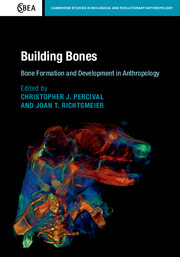Book contents
- Building BonesBone Formation and Development in Anthropology
- Cambridge Studies in Biological and Evolutionary Anthropology
- Building Bones
- Copyright page
- Contents
- Contributors
- Introduction
- 1 What Is a Biological ‘Trait’?
- 2 The Contribution of Angiogenesis to Variation in Bone Development and Evolution
- 3 Association of the Chondrocranium and Dermatocranium in Early Skull Formation
- 4 Unique Ontogenetic Patterns of Postorbital Septation in Tarsiers and the Issue of Trait Homology
- 5 Exploring Modern Human Facial Growth at the Micro- and Macroscopic Levels
- 6 Changes in Mandibular Cortical Bone Density and Elastic Properties during Growth
- 7 Postcranial Skeletal Development and Its Evolutionary Implications
- 8 Combining Genetic and Developmental Methods to Study Musculoskeletal Evolution in Primates
- 9 Using Comparisons between Species and Anatomical Locations to Discover Mechanisms of Growth Plate Patterning and Differential Growth
- 10 Ontogenetic and Genetic Influences on Bone’s Responsiveness to Mechanical Signals
- 11 The Havers–Halberg Oscillation and Bone Metabolism
- 12 Structural and Mechanical Changes in Trabecular Bone during Early Development in the Human Femur and Humerus
- Appendix to Chapter 3: Detailed Anatomical Description of Developing Chondrocranium and Dermatocranium in the Mouse
- References (not included in citations for Chapter 3)
- Index
- 12 Plate section
- References
9 - Using Comparisons between Species and Anatomical Locations to Discover Mechanisms of Growth Plate Patterning and Differential Growth
Published online by Cambridge University Press: 25 March 2017
- Building BonesBone Formation and Development in Anthropology
- Cambridge Studies in Biological and Evolutionary Anthropology
- Building Bones
- Copyright page
- Contents
- Contributors
- Introduction
- 1 What Is a Biological ‘Trait’?
- 2 The Contribution of Angiogenesis to Variation in Bone Development and Evolution
- 3 Association of the Chondrocranium and Dermatocranium in Early Skull Formation
- 4 Unique Ontogenetic Patterns of Postorbital Septation in Tarsiers and the Issue of Trait Homology
- 5 Exploring Modern Human Facial Growth at the Micro- and Macroscopic Levels
- 6 Changes in Mandibular Cortical Bone Density and Elastic Properties during Growth
- 7 Postcranial Skeletal Development and Its Evolutionary Implications
- 8 Combining Genetic and Developmental Methods to Study Musculoskeletal Evolution in Primates
- 9 Using Comparisons between Species and Anatomical Locations to Discover Mechanisms of Growth Plate Patterning and Differential Growth
- 10 Ontogenetic and Genetic Influences on Bone’s Responsiveness to Mechanical Signals
- 11 The Havers–Halberg Oscillation and Bone Metabolism
- 12 Structural and Mechanical Changes in Trabecular Bone during Early Development in the Human Femur and Humerus
- Appendix to Chapter 3: Detailed Anatomical Description of Developing Chondrocranium and Dermatocranium in the Mouse
- References (not included in citations for Chapter 3)
- Index
- 12 Plate section
- References
- Type
- Chapter
- Information
- Building Bones: Bone Formation and Development in Anthropology , pp. 205 - 232Publisher: Cambridge University PressPrint publication year: 2017



